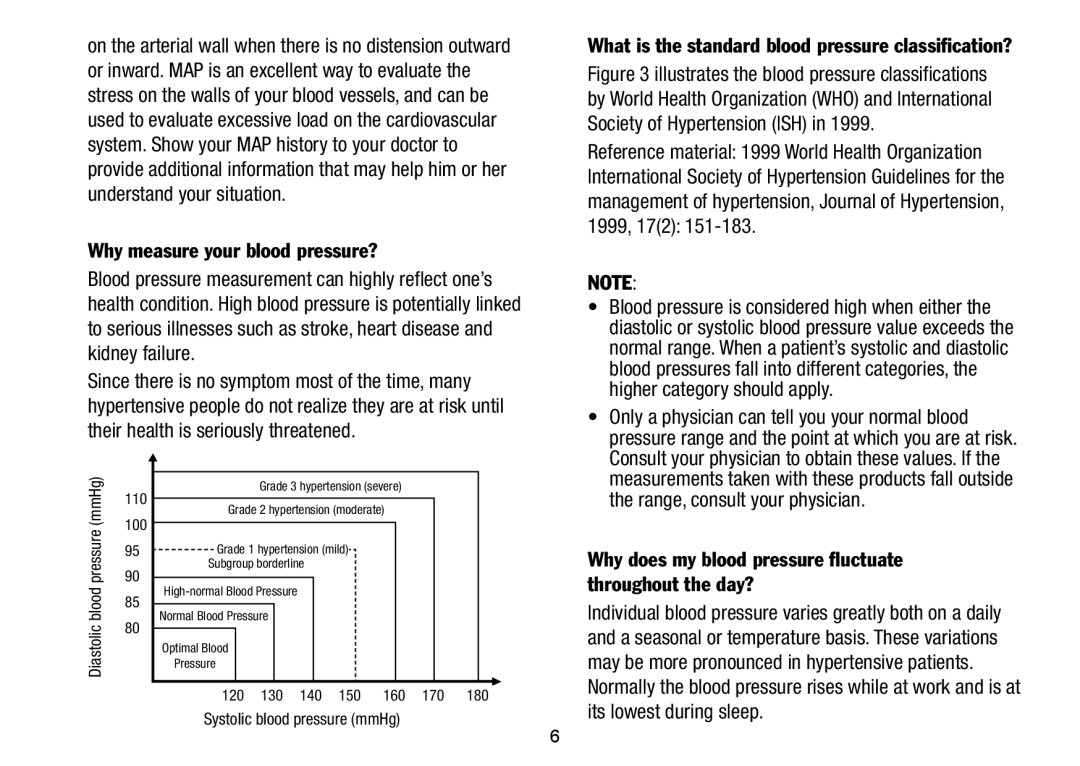
on the arterial wall when there is no distension outward or inward. MAP is an excellent way to evaluate the stress on the walls of your blood vessels, and can be used to evaluate excessive load on the cardiovascular system. Show your MAP history to your doctor to provide additional information that may help him or her understand your situation.
Why measure your blood pressure?
Blood pressure measurement can highly reflect one’s health condition. High blood pressure is potentially linked to serious illnesses such as stroke, heart disease and kidney failure.
Since there is no symptom most of the time, many hypertensive people do not realize they are at risk until their health is seriously threatened.
(mmHg) |
|
|
|
|
|
|
|
|
|
|
|
|
|
|
|
|
110 |
|
|
| Grade 3 hypertension (severe) |
|
|
|
| ||||||||
|
|
|
|
|
|
|
| |||||||||
|
|
|
|
|
|
|
|
|
|
|
|
|
|
|
| |
| 100 |
| Grade 2 hypertension (moderate) |
|
|
|
| |||||||||
pressure |
|
|
|
|
|
|
|
|
|
|
|
|
|
|
| |
|
|
|
|
|
|
|
|
|
|
|
|
|
|
| ||
90 |
|
|
|
|
|
|
|
|
|
|
|
|
|
|
| |
| 95 |
| Grade 1 hypertension (mild) |
|
|
|
|
|
|
| ||||||
|
|
| Subgroup borderline |
|
|
|
|
|
|
|
| |||||
blood | 85 |
|
|
|
|
|
|
|
|
|
| |||||
|
|
|
|
|
|
|
|
|
|
|
|
|
|
| ||
80 | Normal Blood Pressure |
|
|
|
|
|
|
|
|
|
|
| ||||
Diastolic |
|
|
|
|
|
|
|
|
|
|
|
|
|
|
| |
| Optimal Blood |
|
|
|
|
|
|
|
|
|
|
|
|
| ||
|
|
|
|
|
|
|
|
|
|
|
|
|
|
| ||
|
| Pressure |
|
|
|
|
|
|
|
|
|
|
|
|
| |
|
|
|
|
|
|
|
|
|
|
|
|
|
|
|
|
|
|
| 120 | 130 | 140 | 150 | 160 | 170 | 180 | ||||||||
Systolic blood pressure (mmHg)
6
What is the standard blood pressure classification?
Figure 3 illustrates the blood pressure classifications by World Health Organization (WHO) and International Society of Hypertension (ISH) in 1999.
Reference material: 1999 World Health Organization International Society of Hypertension Guidelines for the management of hypertension, Journal of Hypertension,
1999, 17(2): 151-183.
NOTE:
•Blood pressure is considered high when either the diastolic or systolic blood pressure value exceeds the normal range. When a patient’s systolic and diastolic blood pressures fall into different categories, the higher category should apply.
•Only a physician can tell you your normal blood pressure range and the point at which you are at risk. Consult your physician to obtain these values. If the measurements taken with these products fall outside the range, consult your physician.
Why does my blood pressure fluctuate throughout the day?
Individual blood pressure varies greatly both on a daily and a seasonal or temperature basis. These variations may be more pronounced in hypertensive patients.
Normally the blood pressure rises while at work and is at its lowest during sleep.
